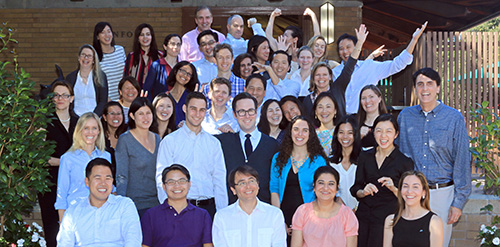Education

The Department of Dermatology at Stanford University School of Medicine offers a three or four-year residency program accredited by the American Board of Dermatology. This program is designed to provide training that will allow the resident to achieve a high degree of competence in clinical dermatology as well as special training in the basic sciences pertinent to the teaching, research, and practice of dermatology.
- Facilities
- Residency Education
- Subspecialities
- Teaching conferences
- Clinical and Basic research
- Application Process
- Benefits
Because Stanford comprises a unique combination of basic scientists and clinicians working together on problems of basic biology and disease, the Department of Dermatology offers a three or four-year program that combines intensive experience in clinical dermatology with rigorous research training in clinical or basic laboratory investigation.
Individuals who have completed an approved internship program will be considered for appointments to the first year (PGY-2) of the residency program. Appointments for the Stanford University Hospital and all affiliated hospitals are made by the Department of Dermatology. Applications are processed through the National Residency Matching Program.
Facilities
Stanford University Medical Center is located on the campus of Stanford
University in Stanford, California, 35 miles south of San
Francisco. The
medical center is a complex of interconnected buildings consisting
of Stanford University Hospital (665 beds), Lane Medical
Library, and Lucile Packard Children's Hospital, (150-bed
pediatric hospital with inpatient and outpatient pediatric
patients).
The adult dermatology outpatient clinic and academic offices are located a short drive away at the Stanford Medicine Outpatient Center, 450 Broadway Street, Redwood City, CA. Facilities for clinical trials, cutaneous surgery, Mohs micrographic surgery laser therapy, phototherapy, and a laboratory for clinical diagnosis are available at the clinic. The adult and pediatric dermatology clinics, dermatology surgery clinics, and phototherapy unit treat in excess of 21,000 patients per year.
The following are available to the residents: a library/conference room
for group instructions, and a large residents' room complete with computers,
digital equipment, kodachrome slide sets, and a multi-headed teaching microscope.
The dermatology research laboratories occupy a large portion of the
second floor of the Center for Clinical Sciences Research (CCSR) building
adjacent to the main Stanford Hospital medical center.
Library Facilities
Within the Department of Dermatology, the
resident has access to dermatologic literature, journals, and texts (both
U.S. and foreign) dating back to the early 1900's. As part of a generous
endowment for the library by Dr. Jerome Fisher, the Department maintains
not only a wide array of biomedical literature, but also direct access
to computer-based literature for both residents and faculty. Additionally,
an extensive file of Stanford clinical photographs (dating back 30 years),
the American Academy of Dermatology teaching slide collection, and the
Dermatopathology Foundation kodachrome slide set are housed in the Department
for the exclusive use of dermatology residents and faculty.
The Lane Medical Library, which serves the entire Medical Center, contains over 260,000 volumes and subscribes to 2,600 journal titles. It includes an outstanding collection of material on medical history. This library is a center for informational service throughout the Pacific Coast region.
The Community
Stanford University Medical Center is located on the Stanford University
campus near Palo Alto, a suburban community with about 56,000 residents.
Stanford is located in the heart of the San Francisco Bay Area. It is
about an hour's drive from the beautiful Northern California coast, from
San Francisco to the north, and the Silicon Valley and Monterey Peninsula
to the south. The climate of the Stanford area is quite pleasant with
warm, dry, sunny days and cool nights prevailing most of the year. On
any day off, all one needs to do is pick a direction and explore what
the Bay Area has to offer. Skiing, camping, backpacking, and wine-tasting
are popular recreational activities. Lake Tahoe and Yosemite are four
hours away by car, and there are numerous state and national parks nearby.
Palo Alto itself offers a vibrant downtown with a multitude of restaurants and shopping areas. Local and campus events can easily fill one's calendar. The San Francisco Bay Area is also well known for its museums, theaters, restaurants, music, and the arts. Sports activities range from college and intramural programs at Stanford to professional sporting events in San Francisco, Oakland, and San Jose. Residents and their families, as members of the Stanford University Community, can take advantage of the educational, cultural, and outstanding athletic facilities of the University. The hospital also maintains a workout facility exclusively for house staff.

